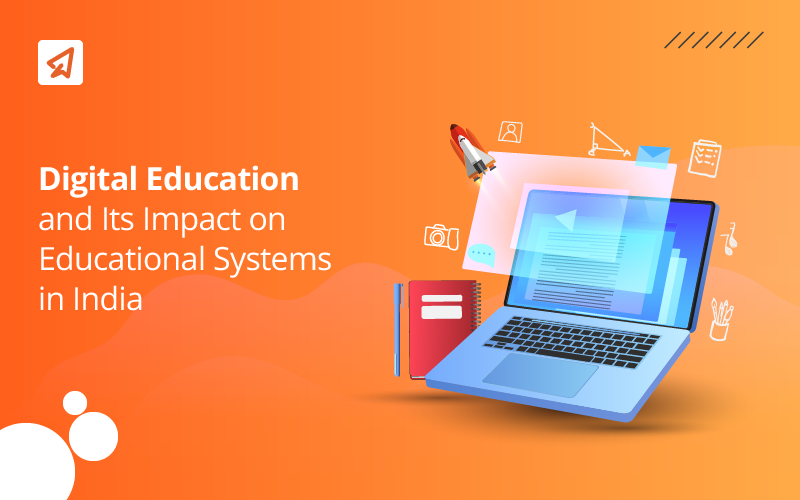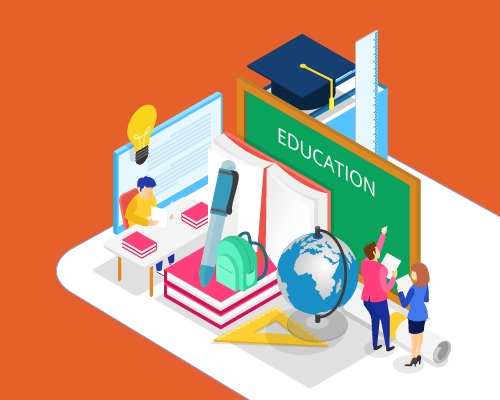How Digital Education Is Transforming Classrooms and Shaping Futures

Have you been in education long enough? If so, you must’ve noticed digital education has completely shifted the way you teach and learn in India. It’s not just about putting textbooks on screens anymore. It’s about smarter classrooms, personalised learning, and students actually enjoying the process!
Moreover, with the goals of NEP 2020 in mind, it feels like government Initiatives for digital education are moving in the right direction.
Where Digital Education Stands Now in India
Let’s start with a quick look at what’s going on. The UDISE+ report of 2023-24 shared some hopeful numbers:
- Around 57.2% of schools now have computers, up from 38.5% in 2019-20.
- And 53.9% have internet access, which was just 22.3% a few years ago.
That’s a big jump, and while India is not all the way there yet, it’s clear more schools are getting connected.
What is Digital Education?
At its core, digital education means using technology to help teach and learn. Think smart classrooms, online classes, virtual labs, video lessons, and learning apps. It makes learning more flexible and way more engaging than old-school chalk and talk.
What are the Advantages of Digital Education?
Here’s what makes digital education really work for students and teachers and how it is a game changer:
- Personalised Learning: Adaptable digital resources allow learners to learn according to their own pace, preference, and learning style. Students can focus more on challenging areas without peer pressure, leading to better comprehension and retention.
- Flexible Access to Learning Resources: Students can access learning resources anytime and anywhere with the help of digital technology. They now have high-quality academic resources at their fingertips. Digital education also involves interacting with other students worldwide to learn from each other and discuss interesting topics with like-minded learners.
It allows learners to study the subjects they are interested in at the pace they prefer, using the mode of instruction that is easiest for them. This feature is especially useful for those who study while working and allow them to continue their education as they earn. - Interactive & Engaging Learning: Interactive lessons, animations, MCQ-based practice, and multimedia learning aids make it easier for learners to grasp new concepts and strengthen their understanding. Digital education uses engaging and interactive learning aids that motivate students to participate in the learning process.
Besides, connectivity to other students enables them to collaborate and work in teams, leading to holistic development. - Data-Driven Insights: You can assimilate and analyse valuable teaching and learning data about your students. It can help them find areas for improvement and develop targeted instruction approaches to overcome them. Analysing individual and class performance data can help you bridge learning gaps and enable your students to focus on their strong areas.
- Holistic Learning Support: Students don’t just memorise stuff. They think, solve, and create with technology. Fresh learning strategies such as gamification, micro-learning, and interactive digital aids are gaining immense popularity in classrooms worldwide. This showcases the impact of digital education technologies in India.
Providing a wide array of learning resources caters to the diverse learning styles of individual learners. It enables them to develop a well-rounded comprehension of subjects. New digital education strategies teach students to adopt and use the latest technology while learning new skills. - Building Community & Improved Communication: The connectivity in smart classrooms helps students and teachers build better relationships. Everyone can ask questions, raise concerns, and work together for holistic education. Better communication channels also foster creativity, critical thinking, and collaboration among all ages.
- Better Learning Outcomes: Students’ learning outcomes could be considerably enhanced by digital schooling. You can develop and implement creative teaching methods that appeal to today’s tech-savvy students with the help of digital tools. When students learn in ways that suit them, they usually do better overall.
Additional factors that contribute to improved learning outcomes include the capacity to monitor progress, pinpoint areas in need of improvement, and deliver prompt feedback. - Affordable Learning: The cost of traditional education is often considerable and includes costs for textbooks, transportation, and physical facilities. Many of these costs are eliminated by digital education, which lowers the cost of education for a wider range of people. Once the setup is done, digital tools can be more cost-effective in the long run.
How Digital Education Can Solve the Biggest Challenges of Indian Education?
The Indian education has grown from a humble 64.9% literacy rate to 74.37% in the past two decades. And yet, there are several challenges that our education system needs to overcome to fulfil our country’s learning needs. Recognizing the importance of digital education, can potentially improve access, quality, equity and relevance to address various problems in our schooling system. Therefore, more educators are adopting digital aids to support their educational endeavours.
Challenge 1 – Bridging the Digital Divide
The digital divide is the gap between those with access to the internet and those without access. According to the 2020 report by IAMAI and Neilsen, only 45% of India’s population has internet access. {SOURCE} That excludes a significant section of the population from the benefits of connectivity and education.
Solution – Digital Libraries
Schools can now create digital libraries with all the relevant learning content. Students can access these libraries using school-owned tablet computers. It can help establish a vast, content-rich, and easy-to-access library for schools at a fraction of the cost of a traditional library.
Now, you can seamlessly integrate state-of-the-art digital infrastructure to enhance the classroom learning environment and make the instruction process more learner-centric. Extramarks partners with schools and colleges to establish a smooth-functioning and reliable digital education infrastructure with our robust and well-trained classroom support.
Challenge 2 – Reluctance Within the Education Fraternity
The education fraternity consists of students, parents, government, educators, and administrators in the education ecosystem. All sections of this fraternity exhibit some degree of inertia at the prospect of adopting technological solutions to traditional education, including digital education in schools. Using a digital tool requires changes in existing systems, training, and extra efforts. Such reluctance from the education fraternity may deter school leaders from implementing digital solutions in their schools.
Solution – User-friendly Educational Platforms
As digital education evolves, new-age online learning tools are simple to use, easy to integrate in traditional education, and engaging for learners. It enables educators to switch from traditional practices to digital education with little effort. Learners also welcome digital aids as they are interactive and engaging, allowing them to learn at their own pace.
Extramarks School Solutions are designed to streamline and automate administrative tasks, support teachers in their pedagogy and build a memorable learning experience for learners. With features like learning analytics, holistic assessments, and two-way communication, Extramarks’ innovative school solutions foster a collaborative educational journey for all stakeholders.
Challenge 3 – Low Enrolment Rate, High Drop Outs, & Low Attendance
Indian government schools have low enrolment and attendance rates, especially at the high school level. According to the UDISE 2021-22 survey, Indian government schools had an enrolment rate of 72.8% {SOURCE}. They also witness high dropouts at all levels.
Solution – Immersive and Engaging Learning Content
Using digital education tools can create a more enriching and engaging learning experience for learners at all levels. Students look forward to interacting with digital learning aids and learn better when they are more engaged and immersed in the learning process.
Extramarks smart class solutions help teachers engage students in the lesson and enjoy the learning experience. Schools that partner with Extramarks experience high enrolment, better attendance and reduced dropout.
Challenge 4 – Historical Learning Gap
India aims to promote inclusivity in education and enable all Indian learners to gain access to high-quality learning opportunities for everyone. However, a historical learning gap has left thousands of students with many years of learning gaps in India. The traditional Indian learning ecosystem cannot cater to the varying needs of students with learning gaps.
Solution – Personalised Learning Solutions
Learning applications with artificial intelligence adapt to a student’s learning needs and level of understanding to create a personalised learning experience. Learning at their own pace empowers learners to overcome learning gaps and catch up with other learners their age.
Extramarks offers personalised adaptive learning solutions through its smart class application. It enables learners to choose their pace and level of study. Our proven learning pedagogy follows the diagnose, learn, practise, test, and evaluate process to create a holistic learning experience for diverse learners.
Challenge 5 – Gender Disparity
Gender disparity is a social issue that exists in all spheres of Indian society. Education is not an exception to this challenge. The Indian education system must overcome the legacy effect of generations of gender inequality to bring female students at par with male students.
Solution – Partnering with Private Educational Institutions for Empowering the Girl Child
Government and NGOs working to uplift women and girl-children at the grassroots level should partner with digital educational institutions to enable girls to pursue their education despite unfavourable circumstances. Online learning solutions can empower girls with the knowledge and awareness they need to improve their social status.
Extramarks Learning App can be used by any student with a phone and an internet connection. Girls living in remote areas of our country can access high-quality learning resources on our application.
Challenge 6 – Measuring Progress & Learning Outcomes
The Indian education system has initiated various programs and schemes for improving education for the untouched pockets of Indian learners. However, measuring the progress of the learners studying under such initiatives and analysing the learning outcomes of the government’s initiatives is a challenge.
Solution – Digital Monitoring & Reporting Data
Digital learning can measure and analyse the learners’ and teachers’ interaction with the application anytime and anywhere. It can help the government and schools find vital information about education initiatives’ engagement and learning outcomes.
Extramarks Smart Class Pus Program enables educators to gather valuable insights about their learners and their application usage. We enable educators to design hassle-free assessments for unlimited classroom practice – even if your students prefer paper and pen exams; you can instantly grade the papers and gather data about the learning outcomes in real time.
Challenge 7 – Apprehension About the Cheating Prevention Abilities of E-learning Platforms
Educators who have never worked with online examination platforms doubt their ability to prevent cheating. Students who are adept with technology may easily find a way to cheat the system to achieve a better evaluation grade.
Solution – Establishing Credibility by Using High-End Technology
Advanced technologies like AI and ML, facial recognition, remote proctoring, and intelligent timer solutions can help prevent malpractices. Educational institutions should assess the technology offered by different edtech providers and only partner with those who offer credible solutions.
Extramarks schooling solutions create unique yet similar questions for each student to make cheating impossible during an examination. Educators can create unique learning and testing experiences for each student using unlimited variations of the same questions with our Power Questions feature.
What Initiatives is the Government Taking for Digital Education?
Honestly, the push from the government has been huge. Some standout initiatives include:
- PM SHRI Schools: Over 14,500 schools are being developed into model digital learning spaces.
- Samagra Shiksha Abhiyan: Focuses on improving overall school infrastructure, including tech.
- PM eVIDYA: A full plan to bring together all digital education efforts.
- DIKSHA: Teachers can get resources and training in one place.
- SWAYAM, SWAYAM Prabha: Great platforms for online courses and video lectures.
- E-Pathshala: Digital textbooks and more for students.
- National Digital Library (NDL): A massive resource bank for all kinds of learners.
- Virtual Labs, NPTEL: Students can do practicals online, especially in science and engineering.
- Sign Language Channels and Accessibility Initiatives: Making learning inclusive for all kinds of learners.
The New Tech That’s Shaping Digital Education
Here are some tech trends that are slowly making their way into Indian classrooms:
- AR/VR: Helps make abstract lessons real and visual.
- Gamification: Turning learning into a game keeps students hooked.
- Wearables: Devices that track health and movement are good for holistic development.
- AI-based Assessments: Quick, personalised feedback without extra teacher workload.
- Cloud Storage: Makes sharing and storing lessons super easy.
- Mobile Learning: Most students have phones, even if they don’t have laptops.
- Chatbots: Students can get answers anytime without waiting for the next class
How Extramarks Supports Digital Education
Some amazing tools of Extramarks, like Smart Class Plus and the Assessment Centre, help schools go fully digital while sticking to NEP 2020 goals. Everything from smart boards to custom learning journeys is in one system. It saves teachers a ton of time!
Digital schooling isn’t a luxury anymore! It’s non-negotiable to level the playing field. Yes, there are hurdles, but the progress India has made shows that the country is on the right track.
As teachers, school leaders, and parents, if you work together and embrace this change, you can truly transform the future of learning with the help of digital education in India.
Do Digital Education the RIGHT Way with Extramarks’ Educational Solutions.
Learn MoreLast Updated on June 5, 2025
Reviewed by

Priya Kapoor | AVP - Academics
Priya Kapoor is an accomplished education professional with over 18 years of experience across diverse fields, including eLearning, digital and print publishing, instructional design, and content strategy. As the AVP – Academics at Extramarks, she leads academic teams in creating tailored educational solutions, ensuring alignment with varied curricula across national and international platforms...read more.










